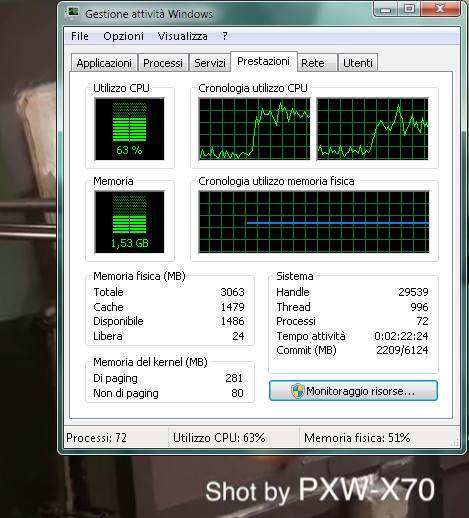This reproduction requires an hardware base with at least powerful as a Core2duo or a quadricore ARM on http://www.iginomanfre.it/x70_hevc_1200

Before (CPU load at 15%) and after starting the 1.2 Mbps 720p24 stream reproduction on my core2duo laptop

In february 2015 the availability of open source HEVC codec (High Efficiency Video Compression, known also as h265) means it is ready to be used by all us.
To read/download the standard reach the ITU website and select the latest available version (as of writing, on may 23rd, the latest release of april 2015 was still not available). All the ITU standards are downloadable for free in pdf format. It is extremely valuable that standards are made public at no cost. For media industries the most known are h262 (mpeg2) and h264 (avc). Please consider how all the international bodies that sell the standards damage the interoperability and the progress of technology, forbidding an easy access the reference documents to the interested audience.
The more than 500 pages of the h265 standard may be too complex at first sight.
For basic informations you may read these Wikipedia articles about the h265 standard or its tiers and levels (the profiles and levels of former MPEG standards).
I remember in 1989 when the first MPEG1 standard papers comes out. A plenty of time passed by, but we must not forget it has been the first brick (even a stone: think to mp3 success!) that affected the technology of media as never before.
I was in.
And today, being HEVC an hot subject, I've not been able to refrain me from writing down something:
embedded 360p24 HEVC embedded html page (february 2015)
It requires videolan VLC player version 2.2.0 (or greater) to be decoded. VLC is available in LGPL from videolan website.
Video embedding is not performed on smartphones for which browsers plug-ins have not been released (and probably will never done).
Smartphones - after installing VLC for android of iOS - may access to the stream http://www.iginomanfre.it/x70_hevc_300
embedded 720p24 HEVC embedded html page (february 2015)
This reproduction requires an hardware base with at least powerful as a Core2duo or a quadricore ARM on http://www.iginomanfre.it/x70_hevc_1200

Before (CPU load at 15%) and after starting the 1.2 Mbps 720p24 stream reproduction on my core2duo laptop
A couple of months after considerations (may 2015)
Further consideration of November 2015
Other things are coming, 4k (4:2:0) downloaded from youtube... but the time to compress them on my small core2duo is terrible.
I remember in 1993, to compress in AVI CIF with Radius Cinepack codec from a PAL signal precropped to CIF: running on a 486 (the maximum available at the time) it required an entire day (23 hours) and the output quality was quite shitty...